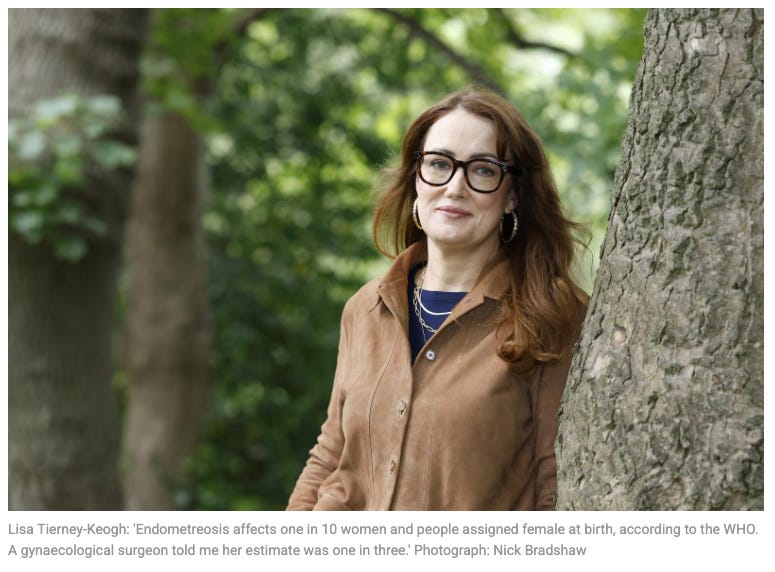Life In Seasons
Every season that passes is one you made it through. Maybe it was easy, maybe this one was harder, but damn it, you’re still here.
Greetings and hello to my new subscribers. I’m so happy you’re here. Here is an excerpt from the essay I have written for the Irish Times, out this weekend in print and online. You can read it here.
“This whole fiasco started in October 2019 with a period so heavy, I turned a hotel bathroom into an abattoir. They’d been heavy since my first, at age 14. And been hella painful, but this one was…bad. So bad, I decide to go to the doctor. I am told it is stress, that there is nothing wrong. I have been told these two sentences so many times in my life, particularly the latter, that I have lost count. This visit to the doctor is a different version of the same experience I have repeated over the course of my lifetime. Something feels wrong, something is wrong, I go to the doctor, and no cause is found. I get sent home believing the thing that is wrong is, in fact, me. And that I shouldn’t believe my own intuition. I doubt myself, think I’m broken, and move on, until the next experience occurs. Rinse and repeat.
In my teens, my periods were so heavy I routinely bled through clothes. I was perpetually anaemic, my iron levels chronically low. When I played my beloved basketball, I’d wear two or three pairs of underwear with multiple pads, cycling shorts, and thanked the heavens my gear was black. At 18 I developed knee pain so bad in both legs my father coined them the Million Pound Knees because they cost him so much in medical bills. It effectively ended my basketball playing and I was told I would never run again. Did you know that leg pain is a common symptom of endometriosis? I didn’t.
This continued into my 20’s, 30’s, and early 40’s. There were other symptoms, like ‘flooding,’ which is exactly what it sounds like. You stand, and gush blood. I ruined more clothes, car seats, and upholstery than I care to remember. At gigs, in pubs, in clubs, the whole body pain from standing would get so bad, I’d drink heavily to numb it. Alcohol is probably the worst thing you can give endometriosis, due to its inflammatory nature. The day after, my hangovers were so severe, and the pain in my legs so bad, I sometimes found it difficult to walk. I laughed it off with my friends. I was just a weakling who couldn’t hack the pace.
In my early 20’s, I developed a mystery hip pain that exists to this day. In my mid 30’s, when I lived in New York, I spent two years in physio, sometimes going twice, three times a week, trying to manage it. I had fancy scans and saw expensive doctors. At no point did anyone I saw consider it might not be a musculoskeletal issue. It affects my ability to sleep, sit, stand, work, exercise, and despite all the treatment and surgeries I’ve had, I still don’t know what this pain is. It's with me every, single day.
“It’s stress. There’s nothing wrong.” I repeat the doctor’s words in my head the month after the hotel abattoir incident. But this time, there’s dizziness and I have to lie down for days. I see another doctor and I’m sent for an ultrasound. I am in the toilet roll aisle of Big Dunnes when I get a call to tell me I have something I’ve never heard of called adenomyosis. I fumble in my bag for a pen. “It often means you also have endometriosis,” the doctor says to me, my head pressing the phone to my shoulder as I mis-spell the word on my hand, “I’m going to refer you to a consultant.”
Endometriosis is as common as diabetes and asthma, and yet it takes, on average, eight to ten years to get diagnosed. It took me 28 years. With symptoms as wide ranging as leg and back pain, shoulder pain, fertility issues, painful bowel issues, headaches, brain fog, chronic fatigue, shortness of breath- and there’s more- the NHS has ranked it in the top 20 most painful conditions. It’s woefully under-researched, with an official estimation that the disease affects one in ten women and people assigned female at birth. Within the patient community, it is widely believed to be far more common than that. We simply know too many women who are either fighting for a diagnosis, or who describe the symptoms and don’t yet know they have it. I once became friends with a gynaecological surgeon doing a fellowship in Ireland who told me they were seeing so many endo cases that her estimate was one in three.
Endo-metri-osis. The word bangs around my brain. I start researching and read through the symptoms. Puzzle pieces click into place as my chest tightens. ‘I have endometriosis,’ I think to myself, silently, daring not to speak it out loud. With all the health problems I’ve endured since childhood, I’ve been branded a hypochondriac so many times, been gaslit into believing what was wrong was me, that my body was fine, but I, Lisa, was the problem.”
I guarantee you know a woman or person assigned female at birth who is suffering, ignored, and dismissed. Maybe they will recognise some of their symptoms in my journey, so please share my piece, and maybe, their journey won’t be as long and hard as mine has been.





